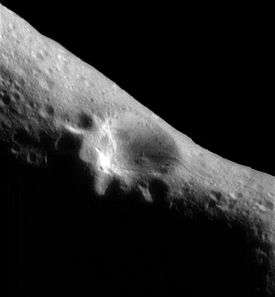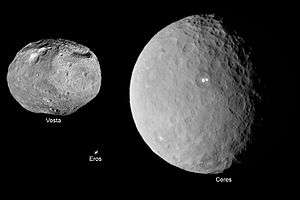433 Eros
|
Six different views of Eros in approximate natural color from NEAR-Shoemaker in February 2000 | |
| Discovery | |
|---|---|
| Discovered by | Carl Gustav Witt |
| Discovery date | August 13, 1898 |
| Designations | |
Named after | Eros |
| 1898 DQ; 1956 PC | |
| Amor I · Mars-crosser | |
| Adjectives | Erotian |
| Orbital characteristics[1] | |
| Epoch October 22, 2004 (JD 2453300.5) | |
| Aphelion | 1.783 AU |
| Perihelion | 1.133 AU |
| 1.458 AU | |
| Eccentricity | 0.223 |
| 1.76 yr (643 days) | |
Average orbital speed | 24.36 km/s |
| 320.215° | |
| Inclination | 10.829° |
| 304.401° | |
| 178.664° | |
| Earth MOID | 0.1492 AU |
| Physical characteristics | |
| Dimensions |
34.4×11.2×11.2 km[1][2] 16.84[1] km (mean) |
| Mass | (6.687±0.003)×1015 kg[3] |
Mean density | 2.67±0.03 g/cm³[1][3] |
| 0.0059 m/s² | |
| 0.0103 km/s | |
| 0.2194 d (5 h 16 min) | |
| Albedo | 0.25[1] |
Spectral type | S[1] |
| +7.0[4] to +15 | |
| 11.16[1] | |
|
| |
433 Eros is an S-type near-Earth asteroid approximately 34.4×11.2×11.2 kilometres (21.4×7.0×7.0 mi) in size, the second-largest near-Earth asteroid after 1036 Ganymed. It was discovered in 1898 and was the first near-Earth asteroid discovered. It was the first asteroid orbited by an Earth probe (in 2000). It belongs to the Amor group.
Eros is a Mars-crosser asteroid, the first known to come within the orbit of Mars. Objects in such an orbit can remain there for only a few hundred million years before the orbit is perturbed by gravitational interactions. Dynamical integrations suggest that Eros may evolve into an Earth-crosser within as short an interval as two million years, and has a roughly 50% chance of doing so over a time scale of 108–109 years.[5] It is a potential Earth impactor,[5] comparable in size to the impactor that created Chicxulub crater and led to the extinction of the dinosaurs.
The NEAR Shoemaker probe visited Eros twice, first with a 1998 flyby, and then by orbiting it in 2000 when it extensively photographed its surface. On February 12, 2001, at the end of its mission, it landed on the asteroid's surface using its maneuvering jets.
History




Discovery
Eros was discovered on 13 August 1898 by Gustav Witt in Berlin and Auguste Charlois at Nice.[6] Witt was taking a 2-hour exposure of Beta Aquarii to secure astrometric positions of asteroid 185 Eunike.[7]
Later studies
During the opposition of 1900–1901, a worldwide program was launched to make parallax measurements of Eros to determine the solar parallax (or distance to the Sun), with the results published in 1910 by Arthur Hinks of Cambridge.[8] A similar program was then carried out, during a closer approach, in 1930–1931 by Harold Spencer Jones.[9] The value obtained by this program was considered definitive until 1968, when radar and dynamical parallax methods became more important.
Eros was the first asteroid detected by the Arecibo Observatory's radar system.[10][11]
Eros was one of the first asteroids visited by a spacecraft, the first one orbited, and the first one soft-landed on. NASA spacecraft NEAR Shoemaker entered orbit around Eros in 2000, and landed in 2001.
Name
Eros is named after the Greek god of love, Erōs. It is pronounced /ˈɪərɒs/ EER-os or sometimes /ˈɛrɒs/ ERR-os. The rarely used adjectival form of the name is Erotian /ᵻˈroʊʃən/.
Physical characteristics
.jpg)

Surface gravity depends on the distance from a spot on the surface to the center of a body's mass. Eros's surface gravity varies greatly because Eros is not a sphere but an elongated peanut-shaped (or potato- or shoe-shaped) object. The daytime temperature on Eros can reach about 100 °C (373 K) at perihelion. Nighttime measurements fall near −150 °C (123 K). Eros's density is 2.67 g/cm3, about the same as the density of Earth's crust. It rotates once every 5.27 hours.
NEAR scientists have found that most of the larger rocks strewn across Eros were ejected from a single crater in an impact approximately 1 billion years ago.[13] (The crater involved was proposed to be named "Shoemaker", but is not recognized as such by the International Astronomical Union (IAU), and has been formally designated Charlois Regio.) This event may also be responsible for the 40 percent of the Erotian surface that is devoid of craters smaller than 0.5 kilometers across. It was originally thought that the debris thrown up by the collision filled in the smaller craters. An analysis of crater densities over the surface indicates that the areas with lower crater density are within 9 kilometers of the impact point. Some of the lower density areas were found on the opposite side of the asteroid but still within 9 kilometers.[14]
It is theorized that seismic shockwaves propagated through the asteroid, shaking smaller craters into rubble. Since Eros is irregularly shaped, parts of the surface antipodal to the point of impact can be within 9 kilometres of the impact point (measured in a straight line through the asteroid) even though some intervening parts of the surface are more than 9 kilometres away in straight-line distance. A suitable analogy would be the distance from the top centre of a bun to the bottom centre as compared to the distance from the top centre to a point on the bun's circumference: top-to-bottom is a longer distance than top-to-periphery when measured along the surface but shorter than it in direct straight-line terms.[14]
Compression from the same impact is believed to have created the thrust fault Hinks Dorsum.[12]
Data from the Near Earth Asteroid Rendezvous spacecraft collected on Eros in December 1998 suggests that it could contain 20,000 billion kilograms of aluminum and similar amounts of metals that are rare on Earth, such as gold and platinum.[15]
Visibility from Earth
On January 31, 2012, Eros passed Earth at 0.17867 AU (26,729,000 km; 16,608,000 mi),[16][17] about 70 times the distance to the Moon, with a visual magnitude of +8.1.[18] During rare oppositions, every 81 years, such as in 1975 and 2056, Eros can reach a magnitude of +7.0,[4] which is brighter than Neptune and brighter than any main-belt asteroid except 1 Ceres, 4 Vesta and, rarely, 2 Pallas and 7 Iris. Under this condition, the asteroid actually appears to stop, but unlike the normal condition for a body in heliocentric conjunction with Earth, its retrograde motion is very small. For example, in January and February 2137, it moves retrograde only 34 minutes in right ascension.[1]
See also
References
- 1 2 3 4 5 6 7 8 "JPL Small-Body Database Browser: 433 Eros (1898 DQ)" (2008-02-16 last obs). Retrieved 2008-12-11.
- ↑ Jim Baer (2008). "Recent Asteroid Mass Determinations". Personal Website. Retrieved 2008-12-11.
- 1 2 Yeomans, Donald K. (2000). "Radio Science Results During the NEAR-Shoemaker Spacecraft Rendezvous with Eros". Science. 289 (5487): 2085–2088. Bibcode:2000Sci...289.2085Y. doi:10.1126/science.289.5487.2085. ISSN 0036-8075. PMID 11000104.
- 1 2 "NEODys (433) Eros Ephemerides for 2137". Department of Mathematics, University of Pisa, Italy. Retrieved 2010-06-27.
- 1 2 Michel, Patrick; Farinella, Paolo; Froeschlé, Christiane (1996-04-25). "The orbital evolution of the asteroid Eros and implications for collision with the Earth". Nature. 380 (6576): 689–691. Bibcode:1996Natur.380..689M. doi:10.1038/380689a0. Retrieved 2011-02-12.
- ↑ Scholl, Hans; Schmadel, Lutz D. (2002). "Discovery Circumstances of the First Near-Earth Asteroid (433) Eros". Acta Historica Astronomiae. 15: 210–220. Bibcode:2002AcHA...15..210S.
- ↑ Yeomans, Donald K.; Asteroid 433 Eros: The Target Body of the NEAR Mission , Jet Propulsion Laboratory/California Institute of Technology.
- ↑ Hinks, Arthur R. (1909). "Solar Parallax Papers No. 7: The General Solution from the Photographic Right Ascensions of Eros, at the Opposition of 1900". Monthly Notices of the Royal Astronomical Society. 69 (7): 544–67. Bibcode:1909MNRAS..69..544H. doi:10.1093/mnras/69.7.544.
- ↑ Jones, H. Spencer (1941). "The Solar Parallax and the Mass of the Moon from Observations of Eros at the Opposition of 1931". Mem. Roy. Astron. Soc. 66: 11–66.
- ↑ Butrica, Andrew J. (1996). To see the unseen: a history of planetary radar astronomy (2nd ed.). Washington, DC: National Aeronautics and Space Administration. p. 224. ISBN 0160485789.
- ↑ "Introduction to Asteroid Radar Astronomy". UCLA. Retrieved 2014-05-19.
- 1 2 Watters, T. R.; Thomas, P. C.; Robinson, M. S. (2011). "Thrust faults and the near-surface strength of asteroid 433 Eros". Geophysical Research Letters. 38 (2). Bibcode:2011GeoRL..38.2202W. doi:10.1029/2010GL045302. ISSN 0094-8276.
- ↑ Thomas, P. C.; Veverka, J.; Robinson, M. S.; Murchie, S. (2001-09-27). "Shoemaker crater as the source of most ejecta blocks on the asteroid 433 Eros". Nature. 413 (6854): 394–396. Bibcode:2001Natur.413..394T. doi:10.1038/35096513. ISSN 0028-0836.
- 1 2 Thomas, P. C.; Robinson, M. S. (2005-07-21). "Seismic resurfacing by a single impact on the asteroid 433 Eros". Nature. 436 (7049): 366–369. Bibcode:2005Natur.436..366T. doi:10.1038/nature03855. PMID 16034412.
- ↑ "Gold rush in space?". BBC News. Retrieved 13 December 2014.
- ↑ "JPL Close-Approach Data: 433 Eros (1898 DQ)" (2011-11-13 last obs). Retrieved 2011-11-14.
- ↑ "NEODyS-2 Close Approaches for (433) Eros". Near Earth Objects - Dynamic Site. Retrieved 2011-11-14.
- ↑ "AstDys (433) Eros Ephemerides for 2012". Department of Mathematics, University of Pisa, Italy. Retrieved 2010-06-27.
Further reading
- Clark, C. S.; Clark, P. E (March 13–17, 2006). "Using Boundary-based Mapping Projections to Reveal Patterns in Depositional and Erosional Features on 433 Eros". 37th Annual Lunar and Planetary Science Conference. 37: 1189. Bibcode:2006LPI....37.1189C.
- Riner, M. A.; et al. (November 2008). "Global survey of color variations on 433 Eros: Implications for regolith processes and asteroid environments". Icarus. 198 (1): 67–76. Bibcode:2008Icar..198...67R. doi:10.1016/j.icarus.2008.07.007.
External links
| Wikimedia Commons has media related to (433) Eros. |
| Wikimedia Commons has media related to Photos of 433 Eros by NEAR. |
- NEAR Shoemaker spacecraft
- NEAR image of the day archive
- Movie: NEAR Shoemaker spacecraft landing
- The Eros Project (OrbDev's attempts at litigation over their property claim)
- 3D VRML 433 Eros Model
- 3D shape model of Eros (requires WebGL)
- 433 Eros at the JPL Small-Body Database

- NEODys (saved output file from 2007) showing distance and magnitude Ephemerides for Eros during rare oppositions
- The Chicxulub Debate In relation to the K-T extinction.
- Dearborn Observatory Records, Northwestern University Archives, Evanston, Illinois Notations as to historical archived work on asteroid 433 Eros.
- Eros at Opposition in 2012 (Royal Astronomical Society of New Zealand)
- NEAR database by ASU (Image search) (Example)
- Eros nomenclature and Eros map with feature names from the USGS planetary nomenclature page
